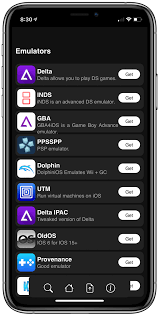Throughout high school, I have independently gained some knowledge in web design. Because I already own a web server on the DigitslOcean network, I decided to challenge myself to utilize DigitalOcean for this project, rather than using the pre-configured web servers shown in class.
SideloadStore
I had originally learned some aspect of web design while designing mu alternative app store for IOS. On iPhones and iPads, Apple typically doesn’t like when people side load apps on their devices unlike android. Sideloading apps can be useful either if one would have a modified version of an app, or wants to install an app not available in your region. While the project was fun during high school when I had no life, I have abandoned the project a few years ago because I had gotten busy and was unable to maintain it.
Instead of WordPress, SideloadStore used a custom CSS from a program called Framework7. FW7 is a specific tool exclusively for making web apps optimized for mobile devices. Framework 7 unlike WordPress, installs completely through the terminal. There is no GUI in FW7, instead the user must know coding knowledge in basic HTML and CSS. Framework 7 only can provide you would the UI, the backend was much more complicated to complete and I had received some help from other developer friends at the time.
The Backend consisted of a script, which signed the app files to a certificate in order to sign on to the device, along with the associated PLIST files to initiate the on device installation. My first attempt with an app signer intigrated with the StarFiles API, allowing mw to save some storage space by hosting app files on the StarFiles servers for free, saving money on my web server. After a few months of useing starFiles, the service would go down often, leaving me to hire a a friend to help me create a native backend to sign apps on site.
The Linux Terminal
SideloadStore (and this website) is hosted on a server rented out by DigitalOcean. Rather than using a server pre configured such as what ReclaimHosting offers, everything on this server was set up from scratch. Setting up a DigitalOcean server requires use of the command line which is something that I have had experience with while creating SideloadStore. Knowing my way around the linux command line, I can easily execute a batch of commands and efficiently update files via SSH and SCP, rather than with a FTP server, such as FileZilla.
Even though I know my way around the linux terminal, I have never used WordPress previously. Setting up WordPress was an absolute pain in this ass. I had to sompleatly reset my server multiple times and start everything from scratch. I had probably followed 10 guides on how to install WordPress on a DigitalOcean servers spending around 7 hours attempting to get it to work. (7pm-1am) Just when everything was successfully installed, I changed a setting and the whole install broke. I then gave up at 1am and reinstalled it the next day.
Using WordPress more, I can see how it could be a helpful tool to easily compile a website with a large amount of customization, even though it was a pain in the ass to install.

Leave a Reply